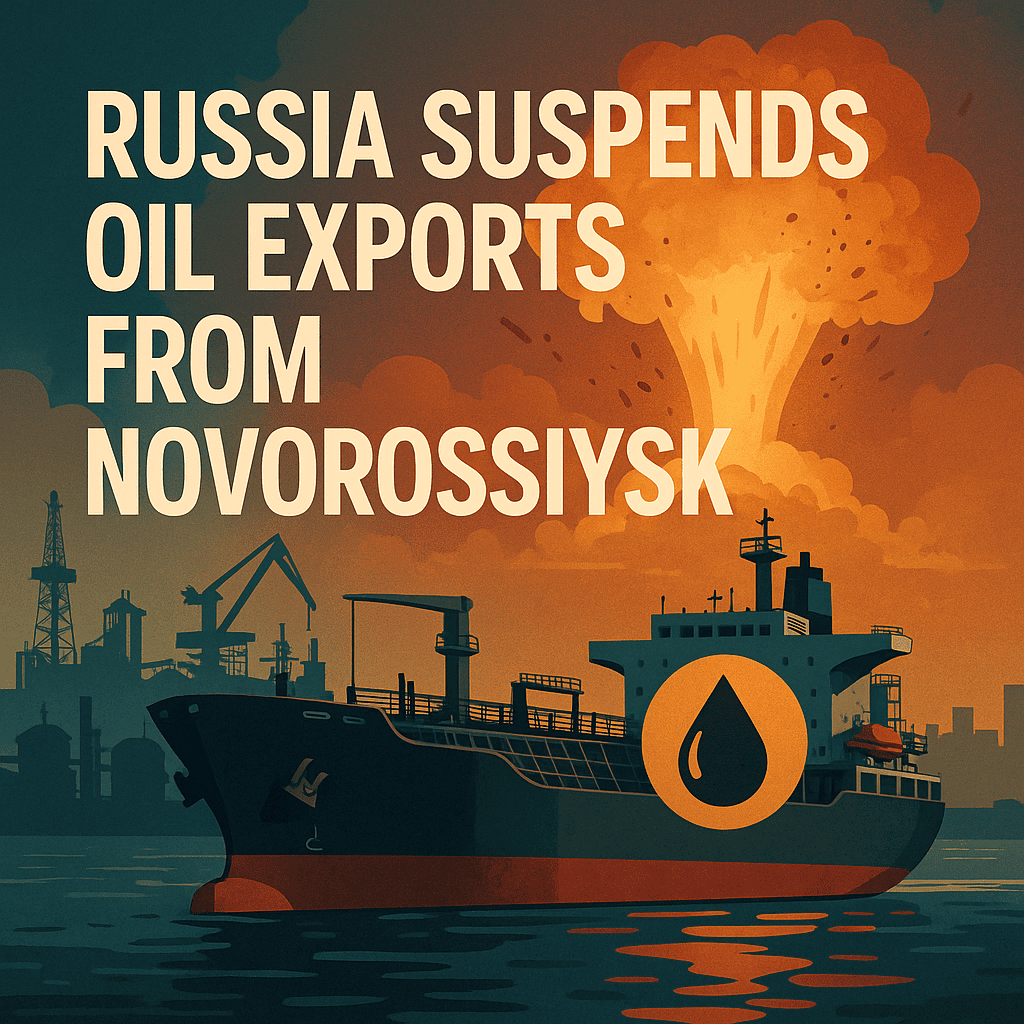Russia Suspends Oil Exports From Novorossiysk After Ukrainian Attack

Russia suspends oil exports from Novorossiysk after a Ukrainian strike damaged critical infrastructure at the Sheskharis export terminal, one of the Kremlin’s most important Black Sea energy hubs. The attack hit port facilities responsible for handling millions of barrels per day, forcing authorities to halt operations while emergency teams assessed structural damage and fire risk. As Russia suspends oil exports from Novorossiysk, market analysts immediately warned that this interruption temporarily removed a significant share of Russian crude from global circulation.
Local officials confirmed that a combination of missiles and long-range drones targeted the coastal terminal, igniting a fire and injuring several crew members aboard a nearby vessel. Video footage circulating online showed flames rising from the harbor and emergency units attempting to contain the blaze. Because Novorossiysk is one of the primary exit points for Russian pipeline oil destined for Europe, Turkey, and global markets, the moment Russia suspends oil exports from Novorossiysk, energy traders reacted with price spikes and increased volatility in crude futures.
Ukrainian authorities have repeatedly described Russian oil infrastructure as legitimate wartime targets, arguing that revenue from oil exports directly finances Moscow’s military activity. Kyiv’s latest strike fits into a broader pattern of attacks on refineries, depots, and transport corridors across southern Russia. Meanwhile, the Kremlin claimed the suspension was temporary and necessary to ensure safe loading conditions, but the fact remains that Russia suspended oil exports from Novorossiysk at a moment of heightened regional tension.
After initial assessments, limited operations resumed, yet the episode highlights the vulnerability of Black Sea energy routes. Tankers remain cautious, insurers are tightening risk requirements, and shipping companies are reviewing whether rerouting will be necessary. Industry experts note that even brief disruptions ripple outward, affecting refinery scheduling, tanker allocation, and short-term supply balances. Every time Russia suspends oil exports from Novorossiysk, the global energy system receives a stark reminder of how exposed major terminals are to targeted strikes.
Forecasting the next phase, analysts expect Russia to reinforce coastal defenses, diversify export pathways, and lean more heavily on ports less vulnerable to Ukrainian drones. However, the attack has already demonstrated that a single strike on the Black Sea network can destabilize markets far beyond the region.
The document outlines how the Burevestnik’s miniature nuclear reactor is designed to keep the missile airborne for extraordinarily long periods, enabling it to approach targets from non-standard directions, including Arctic and trans-polar routes where radar coverage is weaker. This capacity to remain in flight for extended durations and to manoeuvre repeatedly mid-course is central to NATO’s concern.
While the Burevestnik is not classified as hypersonic, NATO analysts noted that its ability to alter direction multiple times during flight could overwhelm conventional tracking systems. The report also describes speeds above 900 km/h and a launch profile compatible with mobile platforms, adding further uncertainty to detection timelines. The alliance acknowledged vulnerabilities inherent to such a missile — particularly during long-endurance flights — but warned that its operational concept is specifically designed to exploit gaps in the alliance’s defensive architecture.
The concerns extend beyond a single weapons system. NATO’s assessment also tracks Russia’s SS-X-28 Oreshnik, reportedly tested in Ukraine in late 2024 and believed to have a range of up to 5,500 kilometres with variable warhead options, including nuclear. Belarus is expected to host deployments of this missile starting in December. Meanwhile, Russia’s Poseidon nuclear-capable underwater drone, targeted at strategic ports and coastal cities, is projected to enter service later in the decade.
Behind the immediate alarm lies a broader strategic interpretation: Russia appears to be committed to developing systems that circumvent or neutralize the effectiveness of existing NATO missile defenses. Several defence analysts cited in the report argue that Moscow’s pursuit of exotic, reactor-driven or underwater nuclear systems is designed to complicate deterrence calculations for the West. Others stress the inherent operational risks, noting that earlier Burevestnik tests resulted in fatal accidents and measurable radiation spikes.
For NATO planners, the assessment highlights a long-term challenge: the gradual maturation of Russian capabilities, which are explicitly aimed at exploiting gaps in surveillance, early warning, and interception technologies.
Also Read: NATO Alarmed by Russia’s Burevestnik Missile as Nuclear-Powered System


















































